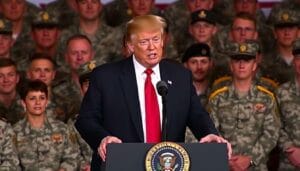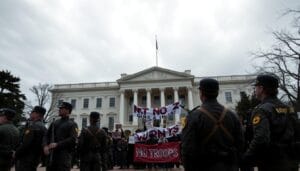Government Shutdown Fallout: Thousands of Federal Workers Suddenly Fired
Discover the impact on federal employees as thousands of federal workers fired during 2nd week of government shutdown ripple through communities.

Government Shutdown Fallout
Click to summarize this article.
Government Shutdown Fallout: In the second week of the government shutdown, President Donald Trump ordered cuts to take effect across many federal agencies. Russell Vought, the director of the Office of Management and Budget, announced on X that the cuts had started. This move is more severe than usual furloughs.
Approximately 4,000 federal workers received layoff notices, and more are expected to follow. The administration sees these actions as significant. Yet, they won’t name all the affected agencies.
This move differs from past shutdown strategies, which have employed furloughs. Essential staff are working without pay, causing disruptions. The latest news suggests a shift in policy.
On Capitol Hill, talks are stuck over health policy and funding bills. With hundreds of thousands furloughed, those fired face permanent job losses. The move raises legal and economic questions for the future.
The shutdown began on October 1 and shows no signs of coming to an end. The Justice Department reported the first wave of cuts. Markets are watching for labor signals and the jobs report.
For now, the focus is on how many more will be fired as agencies cut back.
Government Shutdown Fallout Key Takeaways
- About 4,000 federal workers received RIF notices during the second week of the shutdown.
- OMB’s Russell Vought confirmed that reductions in force have started across agencies.
- This marks a departure from past shutdowns, which have relied on furloughs rather than permanent cuts.
- Essential staff continue working without pay amid widespread service disruptions.
- Legal and economic fallout is building as more federal employee layoffs are considered.
- Congress remains deadlocked over funding and health policy demands.
Government Shutdown Fallout: What Happened to RIFs Announced Amid Ongoing Government Shutdown
In the second week, the tone shifted. Agencies transitioned from warnings to action as reductions-in-force were implemented. The government shutdown impact deepened, and the debate over priorities grew louder. Reports of federal workers fired surfaced alongside new budget claims and legal pushback.
White House confirms reductions in force across departments and agencies.
The White House confirmed active reductions in force to keep key operations running while funding stalls. Notices were sent to the Departments of Education, Treasury, Homeland Security, Health and Human Services, and the Environmental Protection Agency. The move signaled a sharp turn from past playbooks, with thousands of federal workers fired during 2nd week of the government shutdown becoming a flashpoint for policy and labor groups.
Officials framed the step as a targeted way to manage scarce resources. Critics warned of the broader consequences of a government shutdown for services that families and small businesses rely on every day.
OMB’s Russell Vought: “The RIFs have begun” post on X and official stance
Office of Management and Budget Director Russell Vought announced the decision on X, stating the RIFs had begun and would continue as needed. The message underscored the administration’s stance that federal workers fired were part of a lawful process designed to preserve essential functions.
While exact totals were withheld, an agency filing noted early counts and set expectations for more changes. The official account of the unfolding RIFs outlined the scale and the rationale that agencies are using to sequence actions.
Scale and timing: substantial layoffs during the second week of the shutdown
The pace quickened in week two as layoffs expanded beyond furloughs. Treasury readied sizable notices, while Education trimmed offices below the director level and impacted outreach roles. Homeland Security also faced staffing losses, including units focused on cyber and infrastructure.
With reductions in force moving ahead, the government shutdown impact widened from delayed paychecks to permanent separations. Early filings cited thousands of notices, and additional actions were described as “substantial,” signaling an extended timeline.
Break from precedent: layoffs vs. traditional furloughs in past shutdowns
Past shutdowns relied on furloughs, with back pay restoring wages after funding resumed. This time, layoffs replaced the usual stopgap, marking a departure from precedent and amplifying the consequences of the government shutdown across agencies and communities.
Budget advocates cast the move as a hard pivot to downsizing, echoing broader calls for cuts and realignment in federal programs; see recent debate over federal budget cuts worth billions proposed for context. For families navigating student aid and loan servicing, program shifts layered uncertainty on top of job losses, as highlighted in updates on what borrowers need to know during administrative changes.
“This is an extraordinary step,” said one budget analyst, noting that a rapid transition from furloughs to layoffs raises the stakes for public services and long-term staffing plans.
Government Shutdown Fallout: Thousands of Federal workers were fired during 2nd week of the Government shutdown
The second week of the government shutdown brought about significant changes. Agencies started laying off workers instead of just putting them on furlough. This sudden move left thousands without jobs, and many communities felt the impact.
Initial counts: about 4,000 RIF notices disclosed in a Justice Department filing
A Justice Department filing revealed that over 4,000 workers received layoff notices by the end of the second week. This rapid increase in layoffs shocked many. It marked a big change from the usual temporary furloughs to permanent job losses.
Major news outlets reported on this shift. They noted that thousands of federal workers losing their jobs was a big deal. An analysis showed the scale of initial counts and agency confirmations, giving context to the sudden layoffs.
Agencies impacted: Treasury, HHS, Education, Commerce, HUD, Energy, and Homeland Security
Seven cabinet departments were initially affected, impacting numerous areas of federal service. Treasury and Health and Human Services were at the top of the list. This revealed the widespread nature of the layoffs, even during a brief shutdown.
The layoffs affected many areas, including tax processing, grants, housing support, energy programs, and security. Workers saw empty offices and longer lines. Managers worried about more delays as the shutdown continued.
Department-by-department snapshot: where the thousands of employees were cut
- Treasury: 1,446 notices, hitting revenue collection and taxpayer assistance.
- Health and Human Services: between 1,100 and 1,200, affecting public health and safety-net programs.
- Education: 466, touching grant administration and civil rights enforcement; ongoing debate over agency scope drew fresh attention to Education Department policy battles.
- Housing and Urban Development: 442, slowing housing vouchers and community development work.
- Commerce: 315, from economic data to industry support.
- Energy: 187, affecting program operations and oversight.
- Homeland Security: 176, pressuring security and emergency planning.
These cuts showed a clear pattern: thousands of employees were removed from roles that the public sees every day. Even a few dozen layoffs meant fewer services and longer waits for many offices.
Essential vs. nonessential roles: administration’s rationale for reallocating resources
Officials said they were reallocating personnel to essential duties while awaiting funding. Essential staff stayed, often without pay, while nonessential roles were cut. They aimed to keep vital operations running during the shutdown.
This decision was questioned because layoffs can last longer than the crisis. Yet, agencies said they had to make tough choices due to limited funds and urgent needs. This left thousands of employees uncertain, and communities had to rely on fewer workers to maintain services.
Legal, Political, and Economic Fallout of the Government Shutdown
Seeing thousands of federal workers fired has sparked a considerable debate. It’s not just about money anymore. It’s about the rule of law. The shutdown is affecting courts, committees, and even our daily lives.
Agencies are struggling to balance their duties with the need to cut staff. Communities are feeling the effects, with slower services and long lines.

Union lawsuits: AFGE and AFSCME seek a restraining order against mass firings.
The American Federation of Government Employees and the American Federation of State, County, and Municipal Employees are fighting back. They want to stop mass firings during the shutdown. They claim that these layoffs are illegal and violate workers’ rights.
They point out that the number of workers fired is huge. This is hurting the work of agencies, they claim.
They have evidence to back their claims. A Justice Department response and reports on substantial firings and department-by-department cuts are key to their case. They argue that emergency layoffs are not a legal means of addressing funding issues.
Back pay and statutory duty concerns raised by legal experts
Experts say cutting staff during a shutdown could break the law. It could also make it hard for workers to get back pay. Normal furloughs keep things running smoothly, but mass layoffs do not.
This could lead to legal problems. If the layoffs are later found to be wrong, the government could have to pay damages. This could cost taxpayers a lot.
Congressional standoff: health care policy demands vs. funding bills
Talks have broken down over Medicaid and Affordable Care Act subsidies. Democrats aim to address healthcare in the funding bill. Republicans say policy changes should come later.
Failed Senate votes reveal the complexity of the dispute. The standoff is worsening as federal employee layoffs persist.
Shutdown consequences: service disruptions, furloughs of roughly 750,000, and community impact
Essential workers are working without pay. About 750,000 others are furloughed. Airports, Social Security offices, and local offices are all experiencing delays.
Reports indicate that progress is slow. Delays in benefits and system failures are exacerbating the situation. This highlights the fragility of our safety nets.
- Service bottlenecks grow as federal workers who have been fired leave fewer hands on deck.
- Agencies pause inspections, grants, and permits, intensifying the government shutdown’s impact on small towns and cities.
- Households face missed paychecks, compounding strain beyond Washington.
With thousands of federal workers fired and more cuts planned, everyone is waiting for what’s next. The choice between furloughs and firings will shape the crisis. It will also affect public trust.
Government Shutdown Fallout Conclusion
The second week of the government shutdown marked a turning point. Thousands of federal workers received RIF notices, leading to layoffs. The White House stated that this was done to protect essential services.
But the shutdown’s impact is clear. Programs are disrupted, agencies are strained, and families are missing paychecks. The Justice Department filed about 4,000 notices, as reported in this article on mass layoffs.
Departments such as Treasury and the Department of Health and Human Services experienced layoffs. Unions like AFGE and AFSCME are fighting for back pay. The standoff over Medicaid and the Affordable Care Act has stalled reopening votes.
The shutdown is testing policy and public trust. More departments face extended closures. Until a funding deal is reached, the shutdown’s effects will continue.
Government Shutdown Fallout FAQ
What does “reductions in force” mean during the government shutdown?
Reductions in force, or RIFs, refer to the permanent layoffs of federal employees. Unlike furloughs, which are temporary, RIFs are permanent. During the second week of the shutdown, the White House started RIFs to cut costs and fund essential services.
Who confirmed that federal employee layoffs had started?
Russell Vought, the director of the Office of Management and Budget, announced on X that “The RIFs have begun.” An OMB spokeswoman called the cuts “substantial,” but didn’t give a complete list or final numbers.
How many federal workers have received RIF notices so far?
The Justice Department stated that well over 4,000 federal workers received RIF notices during the second week of the shutdown. More layoffs are expected.
Which agencies were hit first by the federal employee layoffs?
The first wave hit seven cabinet departments: Treasury, Health and Human Services, Education, Commerce, Housing and Urban Development, Energy, and Homeland Security. These cuts affected revenue collection, public health, education, housing, energy, and security.
What are the department-by-department counts disclosed in court filings?
The Justice Department filing gave approximate figures: Treasury (1,446), HHS (between 1,100 and 1,200), Education (466), Commerce (315), HUD (442), Energy (187), and Homeland Security (176). Totals may increase as more RIFs are processed.
Why did the administration choose layoffs instead of furloughs?
The White House chose RIFs to save funds for essential operations during the shutdown. They believe shifting resources helps keep core services running while appropriations are stalled.
How is this shutdown different from past shutdowns?
Past shutdowns used furloughs, and workers got back pay later. This shutdown’s use of thousands of layoffs represents a new approach, resulting in immediate workforce cuts.
What is the government shutdown’s impact on services and communities?
Shutdowns cause service delays, long lines at federal facilities, and suspended programs. Approximately 750,000 federal workers are furloughed, and many essential staff members are working without pay, straining operations nationwide.
What legal action have unions taken against the RIFs?
The American Federation of Government Employees and the American Federation of State, County and Municipal Employees filed suit to block mass firings. They seek a temporary restraining order, arguing RIFs violate statutory duties and strip workers of back-pay protections.
What do legal experts say about federal employee layoffs during a shutdown?
Legal experts warn that large-scale RIFs during a funding lapse are unusual. They could jeopardize agencies’ statutory obligations. Courts will determine whether the executive branch has overstepped its authority and whether workers’ rights have been compromised.
What is driving the political standoff causing the government shutdown?
Democrats want to reverse Medicaid cuts and extend Affordable Care Act subsidies. Republicans say health policy changes should be put on hold until after the government reopens. This split has led to multiple failed Senate votes on funding bills.
Are essential federal employees working?
Yes. Essential employees work to maintain core services, often without pay until funding resumes. Nonessential roles face furloughs or RIFs, as resources are reallocated.
Could federal workers receive back pay after this shutdown?
Furloughed workers typically receive back pay after a funding agreement is reached. But those separated through RIFs generally don’t. Union lawsuits are challenging this approach and its impact on compensation.
How many total federal workers are affected by furloughs and layoffs?
About 750,000 federal workers are furloughed, and around 4,000 have received RIF notices. The number of layoffs could grow if the shutdown continues and agencies expand RIFs.
What are the government shutdown consequences for the economy?
Shutdowns reduce consumer spending by unpaid workers, stall federal contracts, and delay services. This can ripple through local economies and slow growth.
What happens next if Congress and the White House remain deadlocked?
Agencies will operate at reduced capacity, with essential services prioritized. More RIFs and furloughs will continue, and service disruptions will widen until a funding agreement ends the shutdown.





